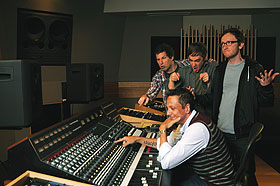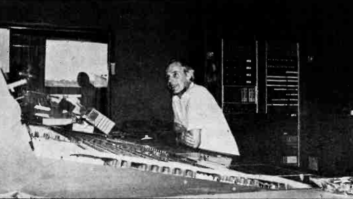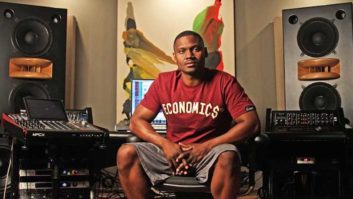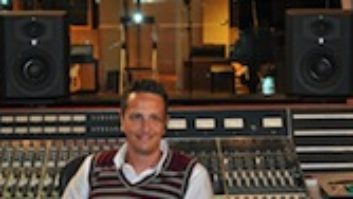
Mix engineer Jason Goldstein seated at Downtown Music Studios’ 16-channel Neve 8014 console with Andy Samberg, Jorma Taccone and Akiva Schaffer
Photo: Jung Kim
Anyone who has watched NBC’s Saturday Night Live in recent years has seen “SNL Digital Shorts”—the wickedly satirical, off-the-wall, manic, edgy and often risqué hip-hop/R&B/pop music videos and conceptual pieces that humorously and mercilessly skewer pop culture. These videos are the creation of The Lonely Island, a comedic and musical trio comprising SNL actors and writers Andy Samberg, Akiva Schaffer and Jorma Taccone. In May 2011, the group released its second album, Turtleneck & Chain (Universal Republic), which includes collaborations with Akon, Justin Timberlake, Snoop Dogg, Rihanna, Michael Bolton, Beck, Nicki Minaj and Santigold.

Samberg, Schaffer and Taccone produced and recorded tracks for Turtleneck and Chain individually and collectively in their own studio spaces, as well as in their offices at NBC’s 30 Rock. When it came time to fine-tune, complete and mix the tracks, they found veteran freelance New York City–based mix engineer Jason Goldstein (jason goldsteinmixer.com), whose track record in hip-hop and R&B (The Roots, Ludacris, Jay-Z) made a solid impression.
“I actually interviewed for the job in person,” Goldstein recalls. “The guys are very into their records and they know exactly what they want. Their main question was, ‘How do you work?’ Because of their [busy] schedules, it was important. They read about how I mix in the box and that intrigued them. Once VCAs and trim automation became available [in Pro Tools], I just jumped in. They contacted me at the end of October and we finished at the beginning of April.” Goldstein works out of his home on a MacBook Pro laptop, and in commercial studios on Pro Tools HD and HD Native setups.
“I did all the editing and compiling of files, and arranging, pitching and tuning, as well as mix the record, and I did a number of vocal overdubs,” Goldstein says. “They solicited beats from a number of producers. They rented a house in Southern California during the summer [of 2010] when SNL was on hiatus, and recorded the bulk of the record [using] Pro Tools LE 8 with varying interfaces. They had all these vocals against a 2-track. I had to reverse-engineer all the edits before I could start mixing. The whole record was recorded, edited and mixed in Pro Tools—either [Version] 8 LE, 9 HD or 9, with this Complete Production Toolkit 2, and on HD TDM, HD Native and laptop-based systems.”
Goldstein and The Lonely Island often exchanged files in the cloud. “They would send me emails or we’d have phone conversations about things that they wanted. I set up a Box.net account, an Internet drop-box, and they just accessed mixes as I threw them up and made comments. When they had to do additional vocals or as we got vocals from their guests, I gave them access to certain areas of the Website, they would upload the files and I’d grab them and put them into the mix. And it was really a very seamless way to do it.”
For all in-person mixing sessions, Goldstein booked Downtown Music Studios in Lower Manhattan’s SoHo neighborhood, which he calls his “go-to studio,” bringing in sessions on a FireWire drive. “The ability to work out of your house is great, but I prefer being in a proper environment,” Goldstein says. “[Downtown Music’s chief engineer] Zach Hancock has done a phenomenal job with it. The vibe is awesome.” They mixed in Studio A, which in January saw the installation of a 16-channel analog Neve 8014 console to go with its Pro Tools HD4 and HD Native setups. “Downtown has matched their rig to mine,” Goldstein says. “Once I was able to open an entire session in my house [and] enter into that exact same session at Downtown, my world just became 100- percent creative.”
Goldstein says that Avid’s release of Pro Tools 9 with the Complete Production Toolkit 2 expansion option was pivotal in refining his workflow for Turtleneck & Chain. “Until I was able to get my hands on Pro Tools 9, I was pretty limited because I had to use very low-latency plug-ins or I had to sit there with a calculator, and anything like that takes away from the creative process. I started [this project] working between LE and an HD4 rig. When Pro Tools 9 with the CPTK2 came out, I was able to work in any of those formats seamlessly.”
Jason Goldstein on Mixing the Lonely Island
Since October 2010, New York City–based mix engineer Jason Goldstein has played a pivotal role behind the scenes with the Lonely Island—Andy Samberg, Akiva Schaffer and Jorma Taccone. Best known for the precisely choreographed and over-the-top visual humor of their “SNL Digital Shorts,” the other half of the Lonely Island’s comic equation comprises the music itself, which they showcase in their second album release, Turtleneck & Chain (Universal Republic, 2011). On the audio side, Goldstein was charged with wrangling and shaping tracks created by the trio and guest producers—in numerous studios—into finished pieces. Along the way, mixing in the box, he worked within tight scheduling and logistical constraints, fashioning a workflow that ultimately accommodated the project.
In this Q&A, Goldstein shares more details about production of Turtleneck & Chain, including the Lonely Island’s creative approach, this project’s inherent challenges and the responsibility of the mix engineer in successfully delivering comedic vocals and lyrics within pop music structures. Goldstein also elaborates on his experiences working in the New York City facility Downtown Music Studios, which originally opened in 2008 as a private facility for artists associated with Downtown Records and Downtown Music Publishing.
How did you land this gig with the Lonely Island?
They had a couple of different people in mind. I had recently done a project for Universal Republic and so I was on their radar. And I’m based in New York and all three of the guys are based in New York. We had lunch and I actually got interviewed for the job in person, which was a somewhat of new experience for me; it’s only happened once or twice before. And I got it, I think, partly based on my discography and partly based on the workflow that I use now. Because of their [busy] schedules, it was important. They definitely did their homework. The guys are very into their records, and they know exactly what they want. They work the same [in] choosing a mastering guy. I don’t feel like I got put through the ringer or anything, but they definitely made an educated decision.
I would imagine they’re very busy with Saturday Night Live during the season, and you had to schedule the mixing sessions from October through April around that.
Both Andy and Akiva are writers so from Wednesday through Sunday, they’re usually gone. Jorma left the show, but he directs movies and other stuff. And Akiva had a baby in December. So getting those three guys in a room for any length of time was an exercise in frustration and logistics. It was crazy. But we did manage to do it on a number of occasions. It was the only way to really get all the ideas solidified.
How did they collaborate with all the other producers involved?
They went the standard pop route in doing this record. They’re the executive producers, but they solicited beats from a number of producers: B-Sides, 6th Sense. They rented a house in Southern California during the summer [of 2010] when SNL was on hiatus and recorded the bulk of the record [using] Pro Tools LE 8 with varying interfaces. They had all these vocals against a 2-track.
They picked beats that they liked, married a bunch of concepts to them and bunkered down at the house in Southern California. They didn’t have tempos. They had done their best to put it on a grid, but they weren’t officially lined up with anything. They edited the 2-tracks to get what they wanted out of them; they couldn’t do exactly what they wanted everywhere because they didn’t have the multitracks. They’re musical guys but not classically trained, so they would flip the beat in all kinds of crazy ways. They would grab a quarter note or an eighth note or a bar, or whatever it was—a half a bar from this section or that section—and create sections out of that. So I had to reverse-engineer all the edits before I could even start mixing. They did a lot of the sound effects.
I was very pleasantly surprised at how well-organized their vocals were—very well labeled. It made the record flow better. It was easier to figure out the other stuff because you knew who was supposed to be where and at what time.
So they worked on their own in Southern California before they brought in any other celebrity guest vocalists.
Yes, so they did all of the [guest vocal] parts. It was hilarious. They [did] references for Nicki Minaj or Michael Bolton or Beck, or any of the other guests.
Did they have specific guest artists in mind from the beginning?
Well, yes and no. Some [songs were] written intentionally with an artist in mind, but some [were] just written as concepts, and the guest artist came later. The one that features Michael Bolton “Jack Sparrow” was written with him in mind. Others were a little bit more generic in that you could say, ‘insert female pop star here.’ Once they had decided on that, they recorded the guest artist and got the multitracks from the producer. Then all that came to me in pieces. I had to put it all together, reverse-engineer it and then mix it.
They had already done a record with Rihanna, and then they did a second one with Rihanna. They wrote “I Just Had Sex” with Akon in mind. They scripted [the songs] like they’d do an SNL script. Obviously, they’re open to any kind of input, but they script it directly and precisely—down to the inflections, the number of tracks, where the ad libs go. It’s just like a sketch on SNL in that respect, or any of the “Digital Shorts” that you see on the show.
They chose beats based on concepts. An example is the Rihanna/Shy Ronnie concept “Shy Ronnie 2: Ronnie & Clyde.” Shy Ronnie is a character who, whenever he’s supposed to be rapping real hardcore, just whispers, and the whole joke is that [Rihanna is] telling him to speak up: “Nobody can hear you.” She steps out of the room and he just hits a verse really hard; as soon as she steps back into the room, he goes back into whispering again. That’s a character that Andy Samberg came up with, so they had to marry that concept to a beat and then [bring in] a guest artist, because that’s what SNL is all about. They’ll take those “Digital Shorts” and just apply that [approach] to making an album.
Certainly the vocal tracks in this particular project are of paramount importance.
You have to keep in mind that the records are jokes and they’re supposed to sound like these amazing pop records or a grimy Beastie Boys record or Jay-Z, or whomever they’re emulating. But the most important thing is the joke. On a pop record, you listen to that melody and those lyrics hundreds of times—it’s blown all over the radio. If you pick a song you like, you listen to it forever. You don’t tell a joke 1,000 times. After you’ve heard the joke once, most people don’t need to hear the same joke five times because it’s not as funny. I think this record is the exception to that rule, but that’s sort of the premise that they operate under.
So first and foremost, you have to get the joke the first time. And that was something that was new to me, having to work the vocals and the track in such a way that it sounded like a pop record and it had all that gloss and finish, but they still got the joke because the joke is paramount.
Every single syllable has to come through perfectly.
The first time, yeah. I had to stay away from certain types of delays I would normally use, or vocal effects, because they would step on the next line. In comedy, a lot of it is timing. They love delays and effects but they have to use the right one; they have to be very specific so they don’t mess with the timing of the joke, of what they were putting out there. And again, they did a good job of dummying up that kind of thing so that I had a good template to work on. I used their delays and their effects as they had them. Sometimes I made it better, and sometimes I didn’t. When I did, they were happy, and they wanted me to try everything. I did most of the EQ and compression, if not all. But we kept some of the effects that they had going on that were specific to the record.
These guys have some production chops.
Absolutely. One of the songs is supposed to sound like two guys in a bedroom who just got a brand-new keyboard for the first time. Jorma actually produced that entirely. He programmed the beat and did the synth and bass lines, and he did it less than exceptionally on purpose. He wasn’t supposed to sound like Rodney Jerkins; he was supposed to sound like a 16-year-old kid who got his very first MPC, or whatever.
It’s fun to make fun of a lack of production chops.
Yeah. They’ll make fun of everything. They have no fear.
Given the time frame of the Turtleneck & Chain project, it was one of the first major-release projects to be done with Pro Tools 9.
Yeah, and that was really great because I was using Pro Tools LE, and some of these sessions were massive with the background vocals by the time I got the tracks. I’d literally have an instrumental session and I would be comping that, editing it, putting it on a grid, figuring out how to reconstruct the 2-track there with a 2-track of the vocals. Then I would put that into the vocal session and go ahead and do whatever pitching, time aligning, cleaning up was necessary on the vocals, and then start trying to marry and comp and get it to the point that I could mix.
And, significantly, you mix completely in the box.
When I committed to going into the box, I fully committed. I was never a hybrid mixer. All of my primary processing was outboard. Pro Tools, for me, was used as a tape machine and something for editing and pitching—production, not mixing. But I decided I wanted to mix in the box. A couple of plug-ins came out that allowed me to emulate that background noise that you get from consoles and outboard gear—tape hiss, for lack of a better word, just white noise. As we all know, with digital, when there’s nothing, there’s nothing. That’s not true in the analog world; when there’s nothing there’s still something—whether it’s audible or not, it’s still there. And once VCAs and trim automation became available [in Pro Tools], I just jumped in. Now I am 100-percent in the box—every bit of it! [Laughs] There’s not a single piece of outboard gear and there hasn’t been for years.
Your mixing sessions with the Lonely Island took place in Lower Manhattan at Downtown Music Studios, which you describe as your “go-to” studio. What is it about that facility that appeals to you?
I use my system in combination with their system to mix records. It’s very accommodating of my particular way of working. It’s a great-sounding room. The clients love it. I love it down there. It’s my first choice of studios in New York at this point. It’s got a full chef’s kitchen. You walk past the label and the publishing arm, and once you hit the studio, you’re completely isolated, and they have their own lounge and their own staff and everything. So you really feel isolated without being isolated.
I understand that you’re a frequent visitor there.
Yeah. I mean, every opportunity, to be perfectly honest. The ability to work out of your house is great, but I’ve been doing this long enough that I prefer being in a proper environment. It’s more conducive to making records. The vibe is awesome. [Downtown Music’s chief engineer] Zach Hancock has done a phenomenal job with it. He’s got a vintage Neve [8014 console] and a ton of great outboard gear. I tracked drums down there for a project, and didn’t have to rent a single thing. [Studio A has] a big control room with natural light, and the small room [Studio B] sounds really punchy. I actually prefer it for mixing because it’s a little smaller and really punchy. It has Genelec [1031As], which I’m familiar with. Their Pro Tools rig is macked out. When I didn’t have my own setup and I needed a TDM rig to do these sessions, it always worked, it always ran smoothly. Not enough can be said for being able to walk into a studio and just have stuff work these days. I think it’s an under-appreciated element. It’s a phenomenal facility.
Which room did you use for mixing?
I was in the A room with the Neve. Having the three guys plus me and the assistant, and occasionally friends or film crews or whatever, made that the right choice. I have a pair of JBL 6328s that I’ve been using that live down there, so I’m very familiar with the way that they sound in the room. I use their rig 90 percent of the time and my hard drive when it was necessary. Downtown has matched their rig to mine. I don’t really have to bring mine down there any more.
My setup fits in a backpack. I was able to take my laptop to the mastering sessions [at Sterling Sound]. Instead of asking [mastering engineer] Chris Gehringer, “Can you bring the vocals out a little bit more,” I just went in the lounge and printed the vocals up a half a dB and gave it back to him.
All in all, Turtleneck & Chain sounds like it worked out as a fun New York City–based project.
I’m in New York, and I love it here, and it’s starting to pay off, being loyal to the city and the people who are still here. I would never have gotten this gig if I were in L.A.—ever.




